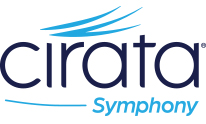Cirata Symphony™ use cases
Data orchestration can sound like an abstract concept. Here are some examples of how Cirata Symphony can be used for real scenarios that you may need solutions for every day.
Data orchestration use case: Data replication
Data rarely stays in just one place. Whether for disaster recovery, faster access from another location, or using another platform's features, replication is a core part of any data architecture.
What's needed for data replication?
At its simplest, data replication means choosing a source and target, and deciding when to start copying; perhaps once, on a schedule, or in response to events like source changes. It can also involve adjusting to conditions like resource limits, failures, or other factors that affect how replication performs. With large amounts of data, replication also needs to handle the changes that can occur to source data while replication is underway, and be able to verify or guarantee outcomes.
Data replication also needs to handle differences between the source and target systems, such as storage limits, naming rules, when the target can't store data in the same way as the source, or to meet business goals like cost or regulatory constraints. Replicating data is more involved than just copying files.
Why data orchestration?
Even if one tool handles replication, you still need to control it based on external factors—like team needs, application requirements, or business changes. Data orchestration makes this easy, and provides the flexibility to meet future needs. Cirata Symphony offers leading data replication capabilities.
Data orchestration use case: AI context
Language models like OpenAI, Anthropic, Mistral and Llama continue to demonstrate broad applicability, with increasingly capable performance against benchmarks and real-world tasks. Model vendors are also providing solutions in specific industries, like: Anthropic Claude for Financial Services
Claude's solution for financial analysis "unifies financial data—from market feeds to internal data stored in platforms like Databricks and Snowflake—into a single interface. Access your critical data sources with direct hyperlinks to source materials for instant verification, all in one platform with expanded capacity for demanding financial workloads."
OpenAI solutions for financial services
OpenAI offers financial services solutions that automate tasks, synthesize market data, reports and research for for insights, personalize client communication and that integrates with a selection of corporate data sources.
Why data orchestration?
AI models work better with task-specific information. Data orchestration helps deliver that context from any data platform, while ensuring security, visibility, and control. Cirata Symphony makes context engineering simple, secure and comprehensive.
Data orchestration use case: Interoperable data
Modern data architectures can simplify data availability and access by using a common, interoperable representation so that data assets can be:
- used from different technologies without needing to be transformed just to suit another system,
- added to and modified without requiring a central coordinator, and
- be robust from change over time, accounting for schema drift, re-partitioning and changing placement efficiently.
Technologies like Apache Iceberg are being adopted rapidly for interoperable data.
Why data orchestration?
Data orchestration simplifies what's needed to connect, organize, and deliver data in interoperable formats—like Apache Iceberg—so that data are available in an open format stays usable, consistent, and accessible across your architecture. Cirata Symphony makes it easy to adopt and optimize the use of interoperable data formats.
Data orchestration use case: Placement and optimization
The costs of storing and maintaining large amounts of data can be significant. Continuous optimization can help minimize data costs by:
- eliminating overheads,
- adopting more cost effective storage choices,
- removing duplicate data assets, and
- improving adherence to business SLAs.
Why data orchestration?
Data orchestration can include continuous data optimization to help minimize costs and increase the efficiency of operating a large data environment. Cirata Symphony simplifies data optimization and placement.

Need more information on Cirata Symphony, visit our Cirata Symphony page, or talk to an expert



